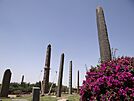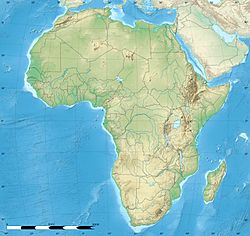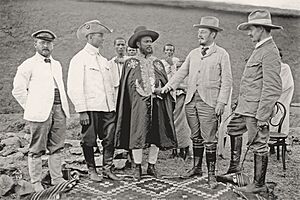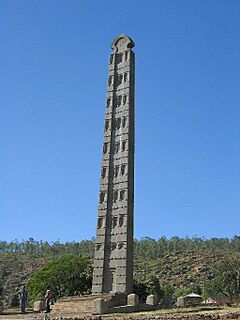Axum facts for kids
Quick facts for kids
Axum
|
|
|---|---|
|
City
|
|
|
From top to bottom, left to right: skyline of Axum, Northern Stelae Park, Chapel of the Tablet at the Church of Our Lady Mary of Zion, Abba Pantelewon, farmlands in Axum, ruins of Dungur.
|
|
| Country | |
| Region | |
| Zone | Central |
| Elevation | 2,131 m (6,991 ft) |
| Population
(2022)
|
|
| • Total | 94,515 |
| UNESCO World Heritage Site | |
| Criteria | Cultural: i, iv |
| Inscription | 1980 (4th Session) |
Axum, also spelled Aksum, is a town in the Tigray Region of Ethiopia. About 66,900 people lived there in 2015. It is famous for being the old capital of the powerful Aksumite Empire.
Axum is located in the Central Zone of the Tigray Region. It sits near the Adwa mountains. The town is about 2,131 meters (6,991 feet) above sea level. It is surrounded by an area called La'ilay Maychew.
In 1980, UNESCO made Axum's old ruins a World Heritage Site. This means they are very important to history. Before a conflict started in 2020, many tourists visited Axum.
Contents
History of Axum
Ancient Times
We don't know much about how Axum grew from a small place to a big empire. But old tools found nearby show people lived there a very long time ago. Digs at a place called 'Beta Giyorgis' suggest a settlement existed around 700 to 400 BC. People have been active in the main Stele Park since the first century AD. By the first century AD, Axum was already called a "metropolis" (a very important city).
Archaeologists have found many interesting things in Axum. One of the most famous things is the use of tall stone pillars called stelae (or obelisks). These were first used as grave markers. Over time, they became huge monuments, some of the biggest in the world. The early stelae were plain. Later ones were carefully shaped from granite. Some were even carved to look like tall buildings.
The buildings in Axum were made with large granite blocks and smaller stones. They used mud to hold them together. Bricks were used for arches and curved roofs. They also had a special wooden frame on the outside. The walls often leaned inward and had recessed parts for extra strength. Similar buildings have been found in other cities like Adulis.
Axum had a good water supply from a large reservoir called May Sum. The area around Axum was good for farming. They grew wheat and had lots of animals. There were also forests for wood. People in Axum were skilled at working with metal, glass, and pottery. They also worked with ivory and leather.
A traveler named Cosmas Indicopleustes visited Axum in the 500s AD. He described the king's palace, which had four towers and bronze statues. Axum also had rows of large granite thrones. These thrones likely had metal statues of old gods. Some thrones had writings that told about wars and victories of kings like Ousanas, Ezana, and Kaleb. Axum was also important for Christian writings. Monks translated many books into the Ge'ez language. The only full copy of the Book of Enoch is in Ge'ez.
After the 700s AD, Axum became poorer and more isolated. This happened when Arab groups took over areas that connected Axum to the Byzantine Empire. Axum stopped being the main capital of the Kingdom of Aksum after the 8th century. The capital moved south. By the end of the 800s, Axum was mostly empty and in ruins. This might have been because the land around it could no longer support a large city.
Medieval Period
Axum became important again when the Solomonic Dynasty rose to power. It became the spiritual center of the Ethiopian Empire. A collection of old Ge'ez writings, called the Book of Axum, tells about the city's history. This book gives details about the church's land and the town's later history. The city also had its own governor, called the Nebure Id. This person was also a high church leader.
The Aksum Seyon was rebuilt in 1406 by Dawit I. People believed it held the Biblical Ark of the Covenant. This Ark is said to contain the Tablets of Stone with the Ten Commandments. Zara Yaqob was crowned there in 1436. He stayed in Axum for three years. Other kings were also crowned in Axum. This special ceremony involved cutting a cord held by the "daughters of Axum." This symbolized the king becoming "king of Zion." The old stone thrones of Axum were used for these coronations.
Francisco Alvares, a Portuguese missionary, visited Axum in the 1520s. He stayed for eight months. He described Axum as a "large town with very good houses." He also saw beautiful old figures of lions and birds on the houses. He thought the town was once home to the Queen of Sheba. He described the Church of Our Lady Mary of Zion as very large and beautiful.
Later History
In the 1500s, a leader named Ahmed ibn Ibrahim al-Ghazi attacked Axum. His troops sacked and burned the city in 1535. The church Alvares described was destroyed. Before the attack, many valuable items from Axum were moved to safety.
After this attack, Axum was mostly in ruins. A visitor named Manuel de Almeida said that in the 16th century, only about 100 people lived there. But Emperor Sarsa Dengel rebuilt the city in 1580. He also restored the church and was crowned there.
In the 1600s, Axum was visited by Jesuit missionaries. The church was burned again in 1611 by the Oromo people. Later, in 1655, Emperor Fasilides had the church restored. His daughter, Princess Yodit, gave a lot of money for it. The church became "marvellous and magnificent."
In the 1700s, travelers like Charles-Jacques Poncet and James Bruce visited Axum. They described the stelae and the church. Bruce thought the city was built mostly by the Ptolemies. Later, Axum came under the control of the rulers of Tigray.
19th Century

In the early 1800s, Axum was doing well economically. It was in a "vast fertile plain" that was "richly cultivated." Most houses were round huts with thatched roofs.
On January 12, 1872, Yohannes IV was crowned Emperor of Ethiopia in Axum.
In 1893, British explorers James Theodore Bent and his wife Mabel Bent came to Axum. They wanted to study old trade routes. But they had to leave quickly because of fighting in the area.
A British journalist, Augustus B. Wylde, visited Axum in 1897. He wrote that after heavy rain, old coins would wash out of the ground. Local boys enjoyed helping visitors find these old coins.
20th and 21st Centuries
In 1906, a German team led by Enno Littmann studied the old remains in Axum.
During the Second Italo-Ethiopian War, Italian troops took over Axum in October 1936. In 1937, they took a 24-meter (79-foot) tall, 1,700-year-old Obelisk of Axum. They broke it into five pieces and shipped it to Rome. This obelisk is a great example of ancient Axumite engineering. Even though there was an agreement in 1947 to send it back, Italy kept it for a long time. This caused a disagreement with Ethiopia, which saw the obelisk as a symbol of its country.
During the Ethiopian Civil War in 1989, Axum was bombed from the air. Three people died.
In April 2005, Italy finally returned the obelisk pieces to Axum. People were very happy. UNESCO helped put the obelisk back together. It was officially shown again on September 4, 2008.
In late 2020, during the Tigray War, many civilians in Axum were killed.
Main Sites of Axum
The most important old monuments in Axum are the steles. These tall stone pillars are about 1,700 years old. They are a symbol of the Ethiopian people. Most of them are in the Northern Stelae Park. The biggest one is the Great Stele, which is 33 meters (108 feet) long. It is thought to have broken during its construction. The Obelisk of Axum is 24.6 meters (81 feet) high. It was returned from Italy in 2005 and put back up in 2008. The next tallest is King Ezana's Stele, which is 24 meters (79 feet) tall. These stelae are believed to mark graves. They were carved with designs that looked like buildings.
Another important part of Axum is the old and new churches of Our Lady Mary of Zion'. The old church was built in 1665 by Emperor Fasilides. People believe it once held the Ark of the Covenant. The very first church here was said to be huge. It was destroyed and rebuilt several times. Only men are allowed into the Old St. Mary's Cathedral.
The New Cathedral of St. Mary of Zion is next to the old one. Emperor Haile Selassie had it built after Ethiopia was freed from Italian rule. This new church allows women to enter. Between the two churches is a small building called The Chapel of the Tablet. It was built at the same time as the new cathedral. Many believe it houses the Ark of the Covenant. Only one special monk is allowed inside this chapel. Even the head of the Orthodox Church and the Emperor were not allowed in. These churches are very holy places for members of the Ethiopian Orthodox Church. Many people go there on pilgrimages.

Other interesting places in Axum include museums with old artifacts. There is also the Ezana Stone. This stone has writing in three ancient languages: Sabaean, Geʽez, and Ancient Greek. It is like the Rosetta Stone. You can also see King Bazen's Tomb, which is a very old stone structure. The so-called Queen of Sheba's Bath is actually an old water reservoir. There are also the ruins of the 4th-century Ta'akha Maryam and 6th-century Dungur palaces. Other sites include Pentalewon Monastery and the rock art called the Lioness of Gobedra.
Local stories say that the famous Queen of Sheba once lived in Axum.
Climate
Axum has a subtropical highland climate. This means it has mild temperatures and a wet season.
| Climate data for Axum | |||||||||||||
|---|---|---|---|---|---|---|---|---|---|---|---|---|---|
| Month | Jan | Feb | Mar | Apr | May | Jun | Jul | Aug | Sep | Oct | Nov | Dec | Year |
| Mean daily maximum °C (°F) | 25.9 (78.6) |
27.2 (81.0) |
28.6 (83.5) |
29.4 (84.9) |
28.8 (83.8) |
27.0 (80.6) |
22.5 (72.5) |
22.3 (72.1) |
24.8 (76.6) |
26.3 (79.3) |
26.8 (80.2) |
25.7 (78.3) |
26.3 (79.3) |
| Daily mean °C (°F) | 16.7 (62.1) |
17.8 (64.0) |
17.7 (63.9) |
21.0 (69.8) |
20.8 (69.4) |
19.7 (67.5) |
17.2 (63.0) |
17.4 (63.3) |
17.9 (64.2) |
17.9 (64.2) |
17.4 (63.3) |
16.2 (61.2) |
18.1 (64.7) |
| Mean daily minimum °C (°F) | 7.5 (45.5) |
8.4 (47.1) |
10.8 (51.4) |
12.7 (54.9) |
12.9 (55.2) |
12.4 (54.3) |
12.0 (53.6) |
12.6 (54.7) |
11.1 (52.0) |
9.6 (49.3) |
8.0 (46.4) |
6.7 (44.1) |
10.4 (50.7) |
| Average precipitation mm (inches) | 3 (0.1) |
2 (0.1) |
9 (0.4) |
27 (1.1) |
31 (1.2) |
67 (2.6) |
221 (8.7) |
199 (7.8) |
67 (2.6) |
12 (0.5) |
13 (0.5) |
1 (0.0) |
652 (25.6) |
| Source: Climate-Data.org (altitude: 2133m) | |||||||||||||
Demographics
In 2012, Axum's estimated population was 56,576 people. About 30,293 were females and 26,283 were males.
A 2007 census showed the town had 44,647 people. Most of them (88.03%) practiced Ethiopian Orthodox Christianity. About 10.89% were Muslim.
In 1994, the population was 27,148. The largest ethnic group was Tigrayans (98.54%). Most people spoke Tigrinya as their first language (98.68%). Again, most people were Ethiopian Orthodox Christians (85.08%), and 14.81% were Muslim.
Transport
Axum Airport, also known as Emperor Yohannes IV Airport, is located about 5.5 kilometers (3.4 miles) east of the city.
Education
Aksum University was built in May 2006. It is about 4 kilometers (2.5 miles) from the center of Axum. The university covers an area of 107 hectares (264 acres). Having a university in Axum is expected to help the country and the region grow.
Notable people
- Abune Mathias (born 1941), who is the "Archbishop of Axum"
- Abay Tsehaye (1953–2021), a politician
- Zera Yacob (1599–1692), a philosopher
- Zeresenay Alemseged (born 1969), a scientist who studies ancient human fossils
Gallery
See also
 In Spanish: Axum (ciudad) para niños
In Spanish: Axum (ciudad) para niños





























